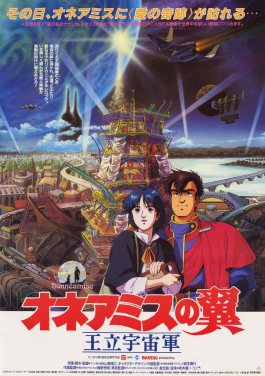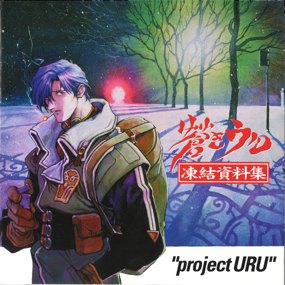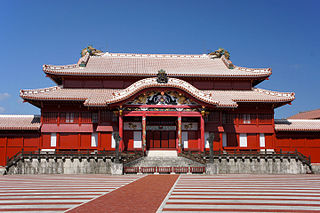
Emperor Nintoku, also known as Ohosazaki no Sumeramikoto (大鷦鷯天皇) was the 16th Emperor of Japan, according to the traditional order of succession. Due to his reputation for goodness derived from depictions in the Kojiki and Nihon Shoki, he is sometimes referred to as the Saint Emperor.

Royal Space Force: The Wings of Honnêamise is a 1987 Japanese animated science fiction film written and directed by Hiroyuki Yamaga, co-produced by Hiroaki Inoue and Hiroyuki Sueyoshi, and planned by Toshio Okada and Shigeru Watanabe, with music by Ryuichi Sakamoto. The story takes place in an alternate world where a disengaged young man, Shirotsugh, inspired by an idealistic woman, Riquinni, volunteers to become the first astronaut. The film was the debut by the studio Gainax, and the first anime produced by Bandai.
The five kings of Wa were kings of ancient Japan who sent envoys to China during the 5th century to strengthen the legitimacy of their claims to power by gaining the recognition of a Chinese emperor during the chaotic period of the Northern and Southern dynasties, when either dynasty was desperate to gain legitimacy over the other by trying to assert itself as the granter of official titles, through garnering as many foreign countries willing to receive titles.
Junichi Okada is an actor, fight choreographer and a former member of Japanese boy band V6.

Wani is a semi-legendary scholar who is said to have been sent to Japan by Baekje of southwestern Korea during the reign of Emperor Ōjin. He used to be associated with the introduction of the Chinese writing system to Japan. He is considered one of the three most influential Toraijins alongside Yuzuki no Kimi and Achi no omi during the Kofun period.

Masaki Okada is a Japanese actor.
Koide Ichijūrō was a Japanese kabuki composer-performer of "long songs" of the Edo period. He was at first a student of Yoshizumi Kosaburo 1st (1699-1753) and identified himself as Yoshizumi Ichijuro. From 1747 he appeared at the Morita-za, one of the three venues of Edo. Afterwards he became a disciple of Fujita Yoshiji 1st, receiving recognition also in Osaka. During the Meiwa-Tenmei period (1764–89) when the meriyasu genre of solo songs was in vogue he received recognition for shirotae and the kouta song kurokami. The name Ichijūrō was taken up by 2nd, 3rd, generation of performers of his songs.

Nana Okada is a Japanese singer-songwriter and actor, represented by Avex Asunaro. She is a former member of the girl groups AKB48 and STU48. She was a fixture on AKB48's major single lineups from 2016 to 2022 and is considered one of the best singers to have been part of the group.

Uru in Blue, also known as Blue Uru, is an unproduced Japanese animated science fiction film project by Gainax intended as a sequel to their 1987 film Royal Space Force: The Wings of Honnêamise. Aoki Uru was originally planned to be directed by Hideaki Anno and scripted by Hiroyuki Yamaga, with Yoshiyuki Sadamoto serving as its chief animation director and character designer. During 1992–93, the Aoki Uru creative team produced a complete storyboard, a partial script, and a large collection of designs and pre-production art for the film; however, the project had been initiated without a secured budget, and its development occurred within a period of personal, financial, and managerial crises at Gainax that contributed to the indefinite suspension of work on Aoki Uru in July 1993.

STU48 (Setouchi48) is a Japanese idol group and sister group of AKB48 named after the Setouchi Region. The group had a shipboard theater from 2019 to 2021. It is co-owned by the tourism board of Setouchi Region and is highly involved in their promotional efforts. The group's captain is Azumi Okada and the vice captain is Akari Fukuda.

The First Shō dynasty was a dynasty of the Ryukyu Kingdom on Okinawa Island in the 15th century, ruled by the First Shō family under the title of King of Chūzan. According to the official history books compiled during the second Shō Dynasty, it lasted from 1406 to 1469. However, the official account is considered unreliable by modern historians because it contradicts contemporary sources.

The Yamato Kingship was a tribal alliance centered on the Yamato region from the 4th century to the 7th century, and ruled over the alliance of noble families in the central and western parts of the Japanese archipelago. The age is from the 3rd to the 7th century, later than the Yamatai Kingdom. After the Taika Reform, the ōkimi as an emperor, at that time, was in power, and the Yamato period ended. The time period is archaeologically known as the Kofun period. Regarding its establishment, due to the relationship between Yamatai and Yamato's succession to the king's power, there are very different views on it.
Ōkimi, or Ame no shita Siroshimesu Ōkimi, was the title of the head of the Yamato Kingship, or the monarch title of Wakoku. This term was used from the Kofun period through the Asuka period in ancient Japan.
Wakoku (倭國) was the name used by early imperial China and its neighbouring states to refer to the nation usually identified as Japan. There are various theories regarding the extent of power of the early kings of Japan. According to the Book of Sui and the History of the Northern Dynasties, its borders were five months from east to west and three months from north to south. The Wajin appear in historical documents such as the Book of Han and the Geographical Survey of Japan from around the 2nd century BC. In the late 7th century, the Yamato kingdom, which had been called Yamato, changed its external name to Japan, but its relation to Japan since Book of the Later Han is not clear. There are discrepancies in the descriptions of the Old Book of Tang and the New Book of Tang.

The yaoi hole is a concept in yaoi, a genre of fictional media depicting homoerotic relations between men aimed at a female audience, that supposes the existence of a male sexual organ that is neither a penis nor an anus. The concept arose from depictions of anal sex in some yaoi works that appeared to defy typical anatomy and physiology, such as representations of penetrative sex in positions that do not correspond to the location of the receiving partner's anus. The yaoi hole as a phenomenon has been alternately considered as reflecting a lack of understanding about male anatomy and anal sex possessed by the writers of early yaoi, and as an intentional exaggeration reflecting a desire for fantasy over realism in pornographic fiction narratives.
During the production of Royal Space Force: The Wings of Honnêamise, the 1987 debut work of anime studio Gainax, the only member of its main staff known to the general public was its musical director, electronic music pioneer Ryuichi Sakamoto, who had recently overseen the soundtrack to the top Japanese box office hit of 1986, Koneko Monogatari. Sakamoto and his assistants from Koneko Monogatari, musicians Koji Ueno, Yuji Nomi, and Haruo Kubota, composed 47 pieces of background music for Royal Space Force in a process that involved using "keywords" given by film director Hiroyuki Yamaga, examining the film's storyboards, making arrangements based on early "prototype" compositions, as well as composing several new original pieces of music as the project developed. 15 of the arrangements would be featured on the film's original soundtrack album.
Koshi Mizukami is a Japanese actor. Until August 2022 he worked under the stage name Kenshi Okada (岡田健史).
Gainax's 1987 debut work Royal Space Force: The Wings of Honnêamise was the first project on which Hiromasa Ogura served as art director; although later noted for creating much of the aesthetic behind the influential 1995 film Ghost in the Shell, Ogura himself in a 2012 interview regarded Royal Space Force as the top work of his career. Working from Yoshiyuki Sadamoto's color scheme and Takashi Watabe's architectural drawings, Ogura then gave a "a sense of life" to the aesthetics of the world setting of Royal Space Force through background paintings created by himself and a staff of 16, including future Studio Ghibli art director Yōji Takeshige, whose first work in the anime industry was on the film. The film's writer and director, Hiroyuki Yamaga, sought to avoid using what he regarded as the usual visual symbolism of anime, and instead wanted Royal Space Force's art direction to express specific times of day and night; Ogura attempted to convey Yamaga's verbal instructions in graphic form.
The very first anime work produced by Gainax following their incorporation as a company in December 1984 was a four-minute "pilot film" version of their concept for an original anime project to be entitled Royal Space Force. The project had been initially pitched to Bandai in September of that year by Hiroyuki Yamaga and Toshio Okada, then associated with Daicon Film, an amateur film group, many of whose staff would shortly join the new professional studio Gainax. Hesitation by Bandai to enter the film business required Gainax to first make the "pilot film" of Royal Space Force as a demo to determine if the project would be saleable. Shigeru Watanabe, an early supporter of the plan at Bandai who would later become co-planner of the feature-length 1987 version of Royal Space Force, showed the pilot film to both Mamoru Oshii and Hayao Miyazaki, already established as successful anime directors, to seek their views; both expressed support for the project.









